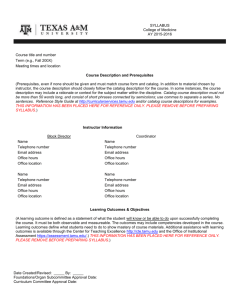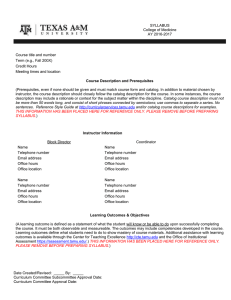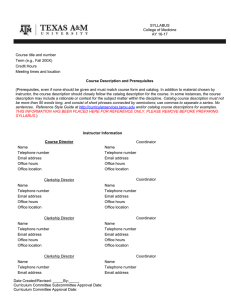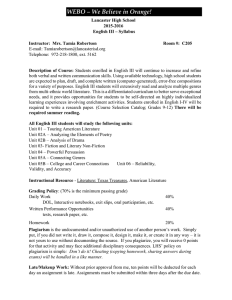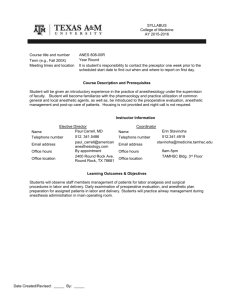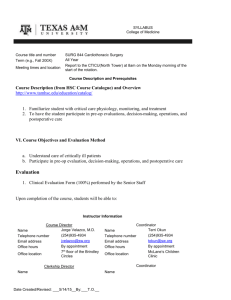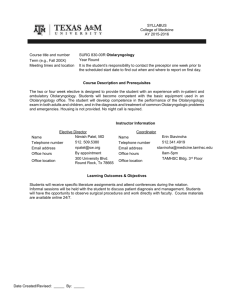Medical Gross Anatomy - College of Medicine
advertisement
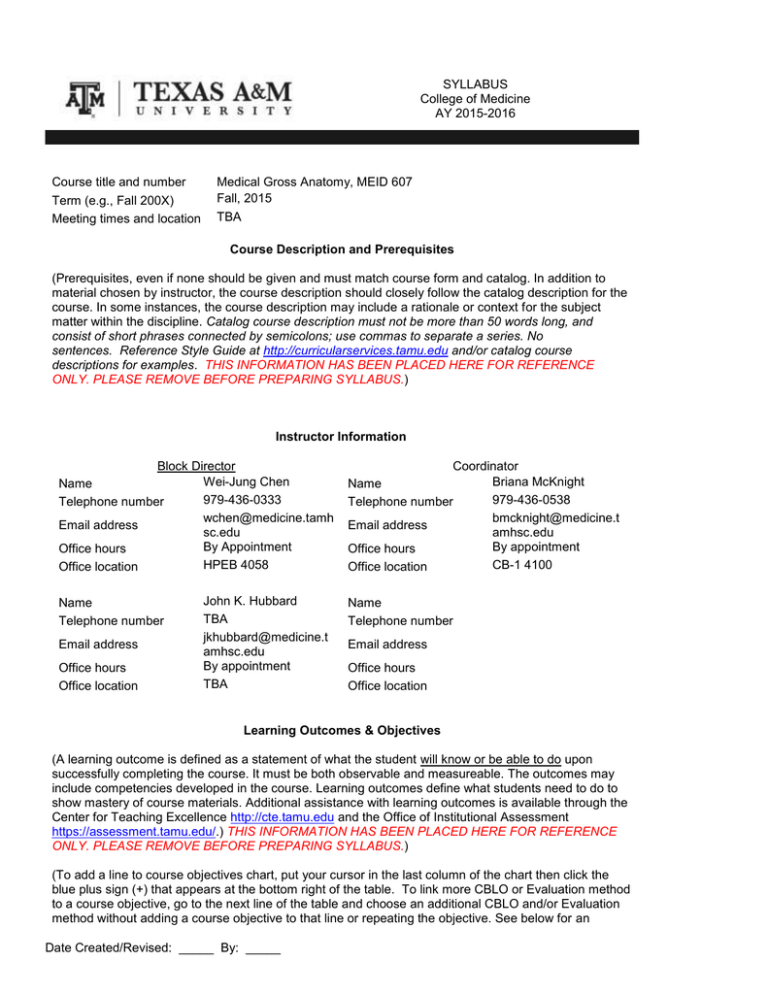
SYLLABUS College of Medicine AY 2015-2016 Course title and number Term (e.g., Fall 200X) Meeting times and location Medical Gross Anatomy, MEID 607 Fall, 2015 TBA Course Description and Prerequisites (Prerequisites, even if none should be given and must match course form and catalog. In addition to material chosen by instructor, the course description should closely follow the catalog description for the course. In some instances, the course description may include a rationale or context for the subject matter within the discipline. Catalog course description must not be more than 50 words long, and consist of short phrases connected by semicolons; use commas to separate a series. No sentences. Reference Style Guide at http://curricularservices.tamu.edu and/or catalog course descriptions for examples. THIS INFORMATION HAS BEEN PLACED HERE FOR REFERENCE ONLY. PLEASE REMOVE BEFORE PREPARING SYLLABUS.) Instructor Information Block Director Wei-Jung Chen Name 979-436-0333 Telephone number wchen@medicine.tamh Email address sc.edu By Appointment Office hours HPEB 4058 Office location Name Telephone number Email address Office hours Office location John K. Hubbard TBA jkhubbard@medicine.t amhsc.edu By appointment TBA Coordinator Briana McKnight Name 979-436-0538 Telephone number bmcknight@medicine.t Email address amhsc.edu By appointment Office hours CB-1 4100 Office location Name Telephone number Email address Office hours Office location Learning Outcomes & Objectives (A learning outcome is defined as a statement of what the student will know or be able to do upon successfully completing the course. It must be both observable and measureable. The outcomes may include competencies developed in the course. Learning outcomes define what students need to do to show mastery of course materials. Additional assistance with learning outcomes is available through the Center for Teaching Excellence http://cte.tamu.edu and the Office of Institutional Assessment https://assessment.tamu.edu/.) THIS INFORMATION HAS BEEN PLACED HERE FOR REFERENCE ONLY. PLEASE REMOVE BEFORE PREPARING SYLLABUS.) (To add a line to course objectives chart, put your cursor in the last column of the chart then click the blue plus sign (+) that appears at the bottom right of the table. To link more CBLO or Evaluation method to a course objective, go to the next line of the table and choose an additional CBLO and/or Evaluation method without adding a course objective to that line or repeating the objective. See below for an Date Created/Revised: _____ By: _____ example. THIS INFORMATION HAS BEEN PLACED HERE FOR REFERENCE ONLY. PLEASE REMOVE BEFORE PREPARING SYLLABUS.) COM Competency Based Learning Objectives: http://medicine.tamhsc.edu/academicaffairs/curriculum/objectives/ Principles and Guidelines for Curriculum Development: http://medicine.tamhsc.edu/policies/pdf/curriculum-principles-guidelines.pdf Course Objective: Learn basic terminology in Medical Gross Anatomy, and develop language skills essential to future education endeavors and effective communication with other health professionals and patients regarding the structure and function of the human body. COM Competency Based Learning Objectives (CBLO): MK1: Demonstrate knowledge of normal human structure and function at the organ-system, tissue, cellular and molecular level; and of the interaction of human systems in maintaining homeostasis Taught (T) and/or Evaluated (E): Taught AND Evaluated Click here to enter text. Develop a three dimensional image/concept of embryogenesis of the major body systems and relate the developmental timeline to frequently seen congenital anomalies. MK1: Demonstrate knowledge of normal human structure and function at the organ-system, tissue, cellular and molecular level; and of the interaction of human systems in maintaining homeostasis Taught AND Evaluated Click here to enter text. Recognize and describe the primary gross anatomical of the human body with particular attention to functional relationships of a structure to all neighboring structures. Develop an appreciation and understanding of the interdependency of anatomical structure. Date Created/Revised: _____ By: _____ MK1: Demonstrate knowledge of normal human structure and function at the organ-system, tissue, cellular and molecular level; and of the interaction of human systems in Taught AND Evaluated Evaluation: Exam Institutionally Developed, Written/ Computerbased Practical (Lab) Exam Institutionally Developed, Written/ Computerbased Practical (Lab) Exam Institutionally Developed, Written/ Computerbased maintaining homeostasis Click here to enter text. Practical (Lab) Develop a three dimensional image and gross anatomical concept of the skeletal, muscular, and organspecific systems of the body (including major function, neurovascular structures, and lymphatic drainage). MK1: Demonstrate knowledge of normal human structure and function at the organ-system, tissue, cellular and molecular level; and of the interaction of human systems in maintaining homeostasis Taught AND Evaluated Click here to enter text. Click here to enter text. Click here to enter text. Click here to enter text. Click here to enter text. Click here to enter text. Click here to enter text. Click here to enter text. Click here to enter text. Exam Institutionally Developed, Written/ Computerbased Practical (Lab) Textbook and/or Resource Material REQUIRED: 1) *Clinically Oriented Anatomy, 7th ed. Moore, Agur, Dalley. ISBN: 978-1451119459. 2) *Langman's Medical Embryology, 12th ed. Sadler. ISBN: 978-1451113426. 3) Atlas of the Human Skull. Sampson, Montgomery, Henryson. ISBN: 978-0890964880. 4) *Atlas of Anatomy, 6th ed. Netter. ISBN: 978-1455704187. 5) Medical Gross Anatomy Dissection Kit. RECOMMENDED: 1) *Gross Anatomy: Board Review Series, 7th ed. Chung, Chung. ISBN: 978-1605477459. 2) *Embryology: Board Review Series, 5th ed. Dudek. ISBN: 978-1605479019. 3) Anatomy: A Photographic Atlas , 8th ed. Rohen, Yokochi, Lütjen-Drecoll. ISBN: 978-1451193183 4) *Atlas of Anatomy (Thieme), 2nd ed. Gilroy, MacPherson, Schuenke et al. ISBN: 978-1604067453. Grading Policies (Must include a grading scale (COM courses must be Honors/Pass/Fail OR Pass/Fail) Ensure grading follows COM and Phase policies. Include weights as applicable to exams, laboratory assignments, field student work, projects, papers, homework, class attendance and participation, and other graded activities in the calculation of the course grade. If more than 10% of grade is based on participation, syllabus should explicitly define and outline how grade is determined. Stacked courses – syllabus must clearly indicate additional work required for graduate students. Changing grading policies should occur only under extraordinary circumstances. THIS INFORMATION HAS BEEN PLACED HERE FOR REFERENCE ONLY. PLEASE REMOVE BEFORE PREPARING SYLLABUS.) Exam 1 to Exam 6 are MAJOR assessments. Date Created/Revised: _____ By: _____ Exam 1 (with lab practical) Exam 2 (with lab practical) Exam 3 (with lab practical) Exam 4 (No lab practical) Exam 5 (with lab practical) Exam 6 (with lab practical) Quiz Honors Pass Fail 18% 15% 15% 7% 18% 20% 7% 100% GRADING SCALE Targeted at 15% 70-100 Below 70 Attendance and Make-up Policies (Include website link to student rule 7 http://student-rules.tamu.edu/rule07. Make sure this information complies with COM policies and Student Handbook. Must include attendance and make-up policy, especially if attendance/class participation will count as a grade. Policies should detail excused absences, unexcused absences, and make-up policies. Attendance and make-up policies should not contradict student rules. REMEDIATION process and policy should be included HERE. THIS INFORMATION HAS BEEN PLACED HERE FOR REFERENCE ONLY. PLEASE REMOVE BEFORE PREPARING SYLLABUS.) Course Topics, Calendar of Activities, Major Assignment Dates (Must include dates on which major exams will be given and assignments will be due and should not be changed without notification of all students in the course. Include a statement that all dates are subject to change. Include major topics, assignments, etc. Reference where an up to date schedule can be accessed. INCLUDE an INITIAL or REPRESENTATIVE schedule in the appendix. THIS INFORMATION HAS BEEN PLACED HERE FOR REFERENCE ONLY. PLEASE REMOVE BEFORE PREPARING SYLLABUS.) See attached schedule – Medical Gross Anatomy Course Schedule Week Topic Date Created/Revised: _____ By: _____ Required Reading Other Pertinent Course Information Clerkship Courses MUST include patient encounter and Log Information here. Actual log list can be included in the appendix. Include information that is pertinent to ALL campus locations here like processes and procedures. If there are campus specifics, include those locally not in this syllabus. Indicate where course materials can be accessed for example Blackboard, One45, etc.) N/A Americans with Disabilities Act (ADA) The Americans with Disabilities Act (ADA) is a federal anti-discrimination statute that provides comprehensive civil rights protection for persons with disabilities. Among other things, this legislation requires that all students with disabilities be guaranteed a learning environment that provides for reasonable accommodation of their disabilities. If you believe you have a disability requiring an accommodation, please contact Disability Services, in Cain Hall, Room B118, or call 845-1637. For additional information visit http://disability.tamu.edu Any student with a disability who needs accommodation should inform the instructor at the beginning of the course. Academic Integrity For additional information please visit: http://aggiehonor.tamu.edu “An Aggie does not lie, cheat, or steal, or tolerate those who do.” College of Medicine Professionalism and integrity Statement (Academic Honesty and Plagiarism) All College of Medicine students are required to comply with the student code of conduct and the academic integrity and honesty standards published in each component’s Student Handbook. Disciplinary action will be taken in accordance with the policies of each component. Students found guilty of Academic Dishonesty will receive an “F”/Unsatisfactory in the course. For a full list of actions qualifying as academic dishonesty, please review the College of Medicine Student Handbook at http://medicine.tamhsc.edu/student-affairs/docs/handbook.pdf. According to the Aggie Honor System Office, plagiarism is defined as the appropriation of another person's ideas, processes, results, or words without giving appropriate credit. Intentionally, knowingly, or carelessly presenting the work of another as one’s own (i.e., without crediting the author or creator). Plagiarism and other academic misconduct definitions can be viewed on the Aggie Honor System Office website; http://aggiehonor.tamu.edu/RulesAndProcedures/HonorSystemRules.aspx#definitions. E-mail Access and FERPA The College of Medicine is communicating all official information to students through the students’ TAMHSC e-mail accounts. Please check the account frequently during the semester for updates. This course is supported with web-based and/or e-mail activities. In order to take advantage of these additional resources and participate fully in the course, you have been assigned an e-mail address by the Texas A&M Health Science Center. This e-mail address is for internal use only, so that faculty may communicate with you and the entire class. By registering for this course, you are agreeing to allow your classmates to have access to this e-mail address. Should you have any questions, please contact the TAMU’s Office of the Registrar at 979-845-1031. The Family Educational Rights and Privacy Act of 1974 (FERPA), which the HSC complies fully, is intended to protect the privacy of education records, to establish the rights of students to inspect and review their education records and to provide guidelines for the correction of inaccurate or misleading data through informal and formal hearings. Students also have the right to file complaints with the Family Educational Rights and Privacy Act Office of the Department of Education in Washington, D.C., concerning alleged failures by the HSC to comply with the act. Mistreatment of Students Date Created/Revised: _____ By: _____ The College of Medicine is committed to providing a positive learning environment in which students can meet their academic goals based on mutual respect in the teacher/learner relationship. Both parties must be sensitive to the needs of others and differences in gender, race, sexual orientation, religion, age or disability. As outlined in the Student Handbook under the section titled Standards of Conduct in the Teacher-Learner Relationship, belittlement, intimidation and humiliation are unacceptable for effective learning and undermine self-esteem. Breaches involving student mistreatment may result in a faculty or staff member being sanctioned or the loss of faculty and/or staff appointment. These policies address student mistreatment involving College of Medicine employees, residents, affiliate staff, or patients. Mistreatment may be reported through the College of Medicine telephone hotline, 1(855)-397-9835 or through an online form at http://medicine.tamhsc.edu/current/student-mistreatment-form.html. For a full list of reporting avenues, please refer to the Student Handbook under the Mistreatment Policy. Exposure and Occupational Hazard The Needle Stick Policy and Bloodborne Pathogen Exposure information for Medical Students may be accessed in the Student Handbook at: http://medicine.tamhsc.edu/student-affairs/docs/handbook.pdf Note: More information is available on the aforementioned topics to all students on the College of Medicine website. Date Created/Revised: _____ By: _____
